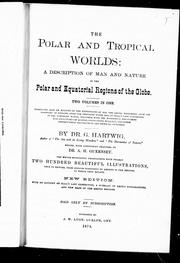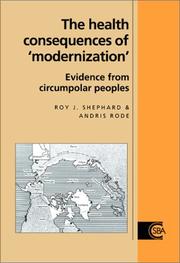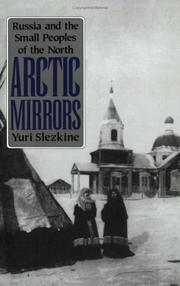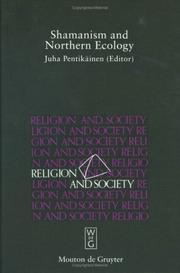| Listing 1 - 10 of 14 | << page >> |
Sort by
|

ISBN: 0665282192 Year: 1874 Publisher: Guelph, Ont. : J.W. Lyon,
Abstract | Keywords | Export | Availability | Bookmark
 Loading...
Loading...Choose an application
- Reference Manager
- EndNote
- RefWorks (Direct export to RefWorks)
Arctic races. --- Natural history. --- Tropics. --- Antarctic regions. --- Arctic regions.
Book
ISBN: 0665097581 Year: 1869 Publisher: London : Longmans, Green,
Abstract | Keywords | Export | Availability | Bookmark
 Loading...
Loading...Choose an application
- Reference Manager
- EndNote
- RefWorks (Direct export to RefWorks)
Arctic races. --- Zoology --- Races arctiques. --- Zoologie --- Antarctic regions. --- Arctic regions. --- Régions antarctiques. --- Régions arctiques.
Book
ISBN: 9781787350137 9781787350120 1787350126 1787350134 1787350150 9781787350151 1787350142 9781787350144 Year: 2017 Publisher: London UCL Press
Abstract | Keywords | Export | Availability | Bookmark
 Loading...
Loading...Choose an application
- Reference Manager
- EndNote
- RefWorks (Direct export to RefWorks)
Climate change and globalisation are opening up the Arctic for exploitation by the world – or so we are told. But what about the views, interests and needs of the peoples who live in the region? This volume explores the opportunities and limitations in engaging with the Arctic under change, and the Arctic peoples experiencing the changes, socially and physically. With essays by both academics and Arctic peoples, integrating multiple perspectives and multiple disciplines, the book covers social, legal, political, geographical, scientific and creative questions related to Arcticness, to address the challenges faced by the Arctic as a region and specifically by local communities. As well as academic essays, the contributions to the book include personal reflections, a graphic essay, and poetry, to ensure wide and varied coverage of the Arctic experience – what the contributions all have in common is the fundamental human perspective. Topics covered in the essays include indigenous identity and livelihoods such as reindeer herding, and adapting to modern identities; a graphic essay on the experience of Arctic indigenous peoples in residential schools; the effects of climate change; energy in the Arctic; and extractive industries and their impacts on local communities. The book includes reflections on the future of Arcticness, engaging with communities to ensure meaningful representation and as a counterpoint to the primacy of environmental, national and global issues.
Arctic peoples. --- Arctic races --- Circumpolar peoples --- Ethnology --- Hyperboreans --- Arctic regions --- Civilization. --- Relations. --- Arctic --- Arctic Ocean Region --- Arctic, The --- Far North --- The Arctic --- Polar regions
Book
ISBN: 0521225884 0521358876 051155804X 0511865929 9780521225885 9780511558047 9780521358873 Year: 1980 Publisher: Cambridge Cambridge University Press
Abstract | Keywords | Export | Availability | Bookmark
 Loading...
Loading...Choose an application
- Reference Manager
- EndNote
- RefWorks (Direct export to RefWorks)
Throughout the northern circumpolar tundras and forests, and over many millennia, human populations have based their livelihood wholly or in part upon the exploitation of a single animal species-the reindeer. Yet some are hunters, others pastoralists, while today traditional pastoral economies are being replaced by a commercially oriented ranch industry. In this book, drawing on ethnographic material from North America and Eurasia, Tim Ingold explains the causes and mechanisms of transformations between hunting, pastoralism and ranching, each based on the same animal in the same environment, and each viewed in terms of a particular conjunction of social and ecological relations of production. In developing a workable synthesis between ecological and economic approaches in anthropology, Ingold introduces theoretically rigorous concepts for the analysis of specialized animal-based economies, which cast the problem of 'domestication' in an entirely new light.
Arctic peoples --- Reindeer --- Economic aspects --- #SBIB:39A6 --- #SBIB:39A11 --- -Achlis --- Cervus tarandus --- Rangifer --- Rangifer tarandus --- Tarandus --- Cervidae --- Caribou --- Arctic races --- Circumpolar peoples --- Ethnology --- Hyperboreans --- Etniciteit / Migratiebeleid en -problemen --- Antropologie : socio-politieke structuren en relaties --- -Arctic peoples. --- -Arctic peoples --- -Etniciteit / Migratiebeleid en -problemen --- -#SBIB:39A6 --- Arctic peoples. --- -Arctic races --- Achlis --- Social Sciences --- Anthropology --- Reindeer - Economic aspects - Arctic regions
Book
ISBN: 907378218X Year: 1993 Publisher: Leiden University Leiden. Centre of non-western studies
Abstract | Keywords | Export | Availability | Bookmark
 Loading...
Loading...Choose an application
- Reference Manager
- EndNote
- RefWorks (Direct export to RefWorks)
Arctic peoples --- -Eskimos --- -Inuit --- -Sami (European people) --- -Laplanders --- Lapps --- Saam (European people) --- Saame (European people) --- Saami (European people) --- Same (European people) --- Samer (European people) --- Samit (European people) --- Ethnology --- Finno-Ugrians --- Innuit --- Inupik --- Eskimos --- Eskimauan Indians --- Esquimaux --- Indians of North America --- Arctic races --- Circumpolar peoples --- Hyperboreans --- Social conditions --- Nooter, G.W. --- Inuit --- Sami (European people) --- Social conditions. --- -Social conditions --- Laplanders
Book
ISBN: 9781845416096 1845416090 Year: 2017 Publisher: Blue Ridge Summit, PA Channel View Publications
Abstract | Keywords | Export | Availability | Bookmark
 Loading...
Loading...Choose an application
- Reference Manager
- EndNote
- RefWorks (Direct export to RefWorks)
This title exclusively addresses tourism and indigenous peoples in the circumpolar North. It examines how tourism in indigenous communities is influenced by academic and political discourses and how communities are influenced by tourism.
Tourism --- Arctic peoples --- Arctic races --- Circumpolar peoples --- Ethnology --- Hyperboreans --- Holiday industry --- Operators, Tour (Industry) --- Tour operators (Industry) --- Tourism industry --- Tourism operators (Industry) --- Tourist industry --- Tourist trade --- Tourist traffic --- Travel industry --- Visitor industry --- Service industries --- National tourism organizations --- Travel --- Social aspects --- Economic aspects
Book
ISBN: 9012048052 Year: 1984 Publisher: 's-Gravenhage Staatsuitgeverij
Abstract | Keywords | Export | Availability | Bookmark
 Loading...
Loading...Choose an application
- Reference Manager
- EndNote
- RefWorks (Direct export to RefWorks)
Acculturation --- Arctic peoples --- Arctic races --- Circumpolar peoples --- Ethnology --- Hyperboreans --- Culture contact --- Development education --- Civilization --- Culture --- Assimilation (Sociology) --- Cultural fusion --- Arctic Regions --- Arctic --- Arctic Ocean Region --- Arctic, The --- Far North --- The Arctic --- Polar regions --- Social conditions. --- Ethnology. Cultural anthropology --- Arctica --- Culture contact (Acculturation)

ISBN: 0521474019 0521065569 0511983727 Year: 1996 Publisher: Cambridge : Cambridge University Press,
Abstract | Keywords | Export | Availability | Bookmark
 Loading...
Loading...Choose an application
- Reference Manager
- EndNote
- RefWorks (Direct export to RefWorks)
What are the health consequences of a transition from an active 'hunter-gatherer' lifestyle to that of sedentary modern living? In this book, the impact of 'modernization' is assessed in various populations in the circumpolar regions. The hazards of living in polar regions, and the adaptations shown culturally, behaviourally and physically by the indigenous peoples are examined and the effect of changes in habitual activity, diet, and general lifestyle due to more urban living patterns on the body composition, pulmonary function and susceptibility to disease discussed. The implications of this switch are important not only for all those concerned about the survival of indigenous communities around the world, but for all of us living in an increasingly sedentary, urban environment. Anthropologists, physiologists and those interested in population fitness will find this a comprehensive and valuable volume.
614 --- Arctic peoples --- -Arctic peoples --- -Human biology --- -Human physiology --- -Physical anthropology --- -Biological anthropology --- Somatology --- Anthropology --- Human biology --- Medical sciences --- Physiology --- Human body --- Biology --- Physical anthropology --- Arctic races --- Circumpolar peoples --- Ethnology --- Hyperboreans --- Openbare gezondheidszorg--(zie ook {351.84}) --- Anthropometry --- Health and hygiene --- Social conditions --- Arctic Regions --- Arctic --- Arctic Ocean Region --- Arctic, The --- Far North --- The Arctic --- Polar regions --- Social conditions. --- Human physiology --- Anthropometry. --- Health and hygiene. --- -Openbare gezondheidszorg--(zie ook {351.84}) --- Biological anthropology --- Arctic regions --- Life Sciences --- General and Others --- Human physiology.

ISBN: 1501703307 1501703315 9781501703317 0801429765 9780801429767 0801481783 9780801481789 9781501703300 Year: 2016 Publisher: Ithaca, NY
Abstract | Keywords | Export | Availability | Bookmark
 Loading...
Loading...Choose an application
- Reference Manager
- EndNote
- RefWorks (Direct export to RefWorks)
For over five hundred years the Russians wondered what kind of people their Arctic and sub-Arctic subjects were. "They have mouths between their shoulders and eyes in their chests," reported a fifteenth-century tale. "They rove around, live of their own free will, and beat the Russian people," complained a seventeenth-century Cossack. "Their actions are exceedingly rude. They do not take off their hats and do not bow to each other," huffed an eighteenth-century scholar. They are "children of nature" and "guardians of ecological balance," rhapsodized early nineteenth-century and late twentieth-century romantics. Even the Bolsheviks, who categorized the circumpolar foragers as "authentic proletarians," were repeatedly puzzled by the "peoples from the late Neolithic period who, by virtue of their extreme backwardness, cannot keep up either economically or culturally with the furious speed of the emerging socialist society." Whether described as brutes, aliens, or endangered indigenous populations, the so-called small peoples of the north have consistently remained a point of contrast for speculations on Russian identity and a convenient testing ground for policies and images that grew out of these speculations. In Arctic Mirrors, a vividly rendered history of circumpolar peoples in the Russian empire and the Russian mind, Yuri Slezkine offers the first in-depth interpretation of this relationship. No other book in any language links the history of a colonized non-Russian people to the full sweep of Russian intellectual and cultural history. Enhancing his account with vintage prints and photographs, Slezkine reenacts the procession of Russian fur traders, missionaries, tsarist bureaucrats, radical intellectuals, professional ethnographers, and commissars who struggled to reform and conceptualize this most "alien" of their subject populations. Slezkine reconstructs from a vast range of sources the successive official policies and prevailing attitudes toward the northern peoples, interweaving the resonant narratives of Russian and indigenous contemporaries with the extravagant images of popular Russian fiction. As he examines the many ironies and ambivalences involved in successive Russian attempts to overcome northern-and hence their own-otherness, Slezkine explores the wider issues of ethnic identity, cultural change, nationalist rhetoric, and not-so European colonialism.
Arctic peoples. --- Arctic peoples --- Indigenous peoples --- Aboriginal peoples --- Aborigines --- Adivasis --- Indigenous populations --- Native peoples --- Native races --- Ethnology --- Arctic races --- Circumpolar peoples --- Hyperboreans --- Russia, Northern --- Arctic Russia --- Kraĭniĭ Sever --- Northern Russia --- Northern Soviet Union --- Russia, Arctic --- Russian Arctic --- Russian-Siberian Arctic --- Soviet North --- Soviet Union, Northern --- Arctic regions --- History --- Ethnic relations. --- Politics and government. --- 323.15 <47> --- 323.15 <47> Nationale minderheden --(binnenlandse politiek)--Rusland. Sovjet-Unie --- Nationale minderheden --(binnenlandse politiek)--Rusland. Sovjet-Unie

ISBN: 3110141868 3110811677 9783110811674 9783110141863 Year: 1996 Volume: 36 Publisher: Berlin New York Mouton de Gruyter
Abstract | Keywords | Export | Availability | Bookmark
 Loading...
Loading...Choose an application
- Reference Manager
- EndNote
- RefWorks (Direct export to RefWorks)
The series Religion and Society (RS) contributes to the exploration of religions as social systems - both in Western and non-Western societies; in particular, it examines religions in their differentiation from, and intersection with, other cultural systems, such as art, economy, law and politics. Due attention is given to paradigmatic case or comparative studies that exhibit a clear theoretical orientation with the empirical and historical data of religion and such aspects of religion as ritual, the religious imagination, constructions of tradition, iconography, or media. In addition, the formation of religious communities, their construction of identity, and their relation to society and the wider public are key issues of this series.
Shamanism --- Arctic peoples --- -Shamanism --- Arctic races --- Circumpolar peoples --- Hyperboreans --- -Sjamanisme. Shamanisme --- -291.612 Sjamanisme. Shamanisme --- Human ecology --- 291.612 --- 291.612 Sjamanisme. Shamanisme --- Sjamanisme. Shamanisme --- Religions --- Ecology --- Environment, Human --- Human beings --- Human environment --- Ecological engineering --- Human geography --- Nature --- Ethnology --- Religion&delete& --- Congresses --- Social aspects --- Effect of environment on --- Effect of human beings on --- Religion --- Arctic regions --- Shamanism - Congresses. --- Shamanism - Arctic regions - Congresses. --- Arctic peoples - Religion - Congresses. --- Human ecology - Arctic regions - Congresses. --- Shamanism - Arctic regions - Congresses --- Human ecology - Congresses --- Arctic peoples - Religion - Congresses --- Human ecology - Arctic regions - Congresses --- Shamanism - Congresses
| Listing 1 - 10 of 14 | << page >> |
Sort by
|

 Search
Search Feedback
Feedback About UniCat
About UniCat  Help
Help News
News